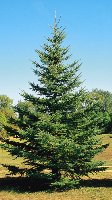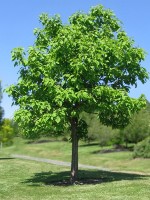Mon-Fri 9am - 5pm Mountain time
Black Hills Spruce vs Northern Catalpa (Cigar Tree)
Picea glauca var. densata
Catalpa speciosa
NOT AVAILABLE THIS SEASON - MIGHT RETURN
Black Hills Spruce is a subspecies of White Spruce native to the Black Hills of South Dakota. It has a strongly conical form, slower growth rate and denser foliage than typical white spruce, making it preferable as a specimen tree for smaller suburban lawns. It also responds well to pruning, and can be used as a hedge or even bonsai.
Northern Catalpa is a striking feature tree with showy flowers, and very large leaves. Its orchid-like flowers are white with yellow and purple accents, and they have a pleasant fragrance. They bloom from late spring to early summer and can last up to two weeks, attracting hummingbirds and pollinators. The leaves are very large, ranging from 15-30 cm long, 12-20 cm wide, forming a canopy that makes it a good shade tree.
They can tolerate dry conditions as well as standing water, air pollution, and salt. These factors and its beauty contribute to its growing popularity as both a boulevard and ornamental tree in colder areas.
Northern Catalpa produces long bean-like capsules and are sometimes called the Cigar Tree in reference to this fruit.
Black Hills Spruce Quick Facts
Northern Catalpa (Cigar Tree) Quick Facts
In row spacing: 3 - 4 m (10 - 12 ft)

